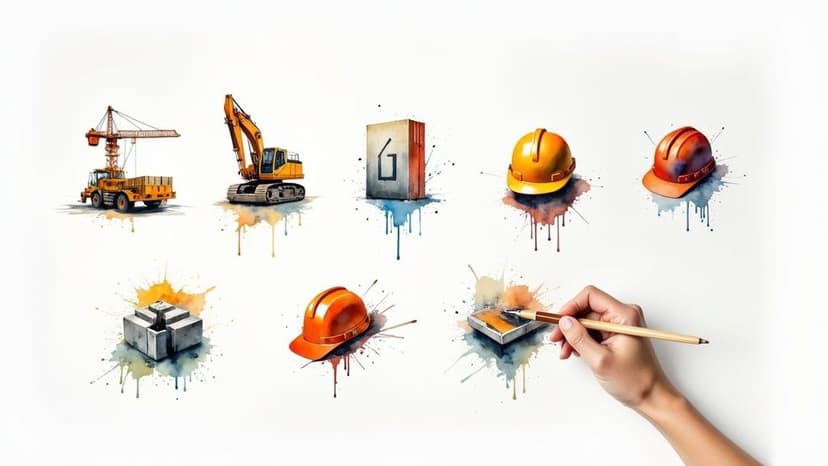
8 Inspiring Construction Companies Logos to Model in 2025
Discover 8 top construction companies logos that build strong brands. Get strategic design insights and actionable tips to inspire your next logo project.
Discover 8 inspiring types of new home images, from minimalist exteriors to smart tech. Find the perfect visual inspiration for your next project or purchase.
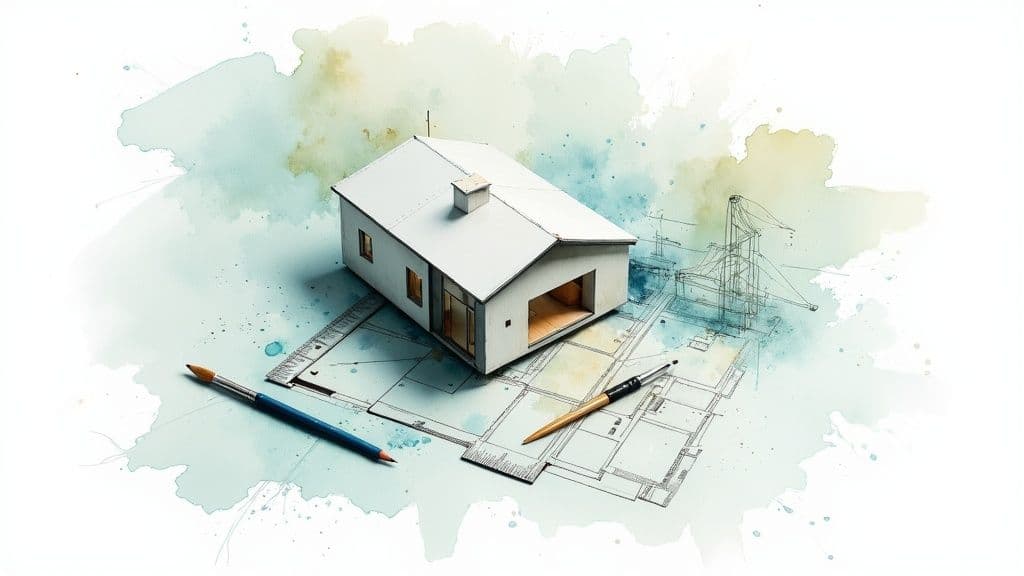
Instastock Team
October 12, 2025 • 13 min read
In the world of property development and home buying, a picture isn't just worth a thousand words; it's worth a sale, a dream, a vision realised. The right new home images can ignite imagination, showcase potential, and set the tone for a project long before the first brick is laid.
Whether you're a developer marketing a new community, a real estate agent listing a pristine property, or a prospective homeowner gathering ideas, the visual language you use is paramount. Your choice of imagery communicates not just a floor plan, but a lifestyle. It needs to be precise, compelling, and perfectly aligned with the audience you want to attract.
This guide moves beyond generic stock photos to explore eight distinct categories of home photography and visualisation. We'll delve into the specific techniques, emotional impact, and strategic advantages of each style, from sleek minimalist exteriors to advanced 3D rendered visualisations. We will provide actionable insights to help you curate or create visuals that truly resonate with modern buyers and design enthusiasts. Let’s explore the images that are shaping how we see, build, and buy homes today. This curated collection is your new blueprint for visual inspiration.
When you think of a truly contemporary home, the modern minimalist exterior is often the first image that comes to mind. This architectural style is defined by its clean lines, geometric precision, and a "less is more" philosophy. It strips away ornate details, focusing instead on the elegant interplay of simple forms and high-quality, natural materials.
The core principle is simplicity, but that doesn’t mean boring. These designs often use a neutral colour palette of whites, greys, and blacks, accented with the warm textures of wood, the sleekness of glass, or the raw appeal of stone and concrete. The result is a structure that feels both sophisticated and deeply connected to its environment, as seen in many Scandinavian and Japanese-inspired new home images.
Creating compelling new home images of a minimalist exterior requires a specific approach. Your goal is to highlight the architectural intent without adding unnecessary clutter.
Moving from the exterior to the inside, luxury interior staging is where a new house truly becomes a home in the eyes of a potential buyer. These new home images are less about documenting rooms and more about selling an aspirational lifestyle. Professionally staged photographs showcase high-end finishes, designer furniture, and curated decor to create a scene that feels both elegant and inviting, helping viewers instantly envision themselves in the space.
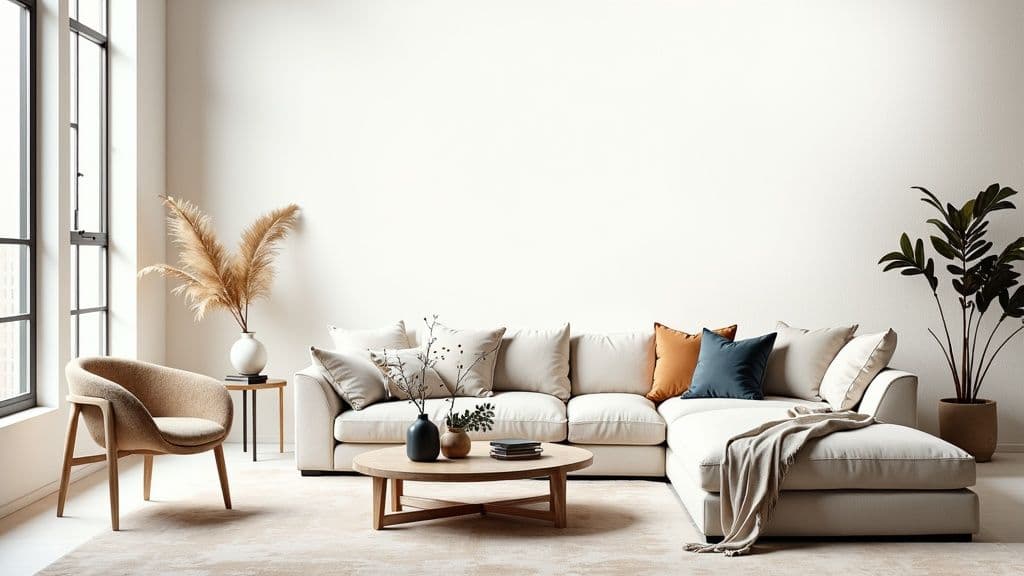
This approach, popularised by high-end real estate firms and celebrity home stagers, is about meticulous curation. Every pillow, piece of art, and decorative object is placed with intent. The goal is to highlight the home's best features, like its spaciousness or premium materials, while creating an emotional connection. The resulting photos look like they belong in a high-end design magazine, which is precisely the point.
Creating magazine-quality staged photos requires a blend of interior design principles and technical photography skills. The focus is on creating a flawless, desirable image.
In an era where convenience and connectivity are paramount, new home images that showcase smart technology are incredibly compelling. These photos go beyond traditional architectural shots to highlight the cutting-edge automation and integrated systems that define a truly modern living experience. They visually communicate a home's intelligence, from smart thermostats and automated lighting to voice-controlled assistants and advanced security systems.
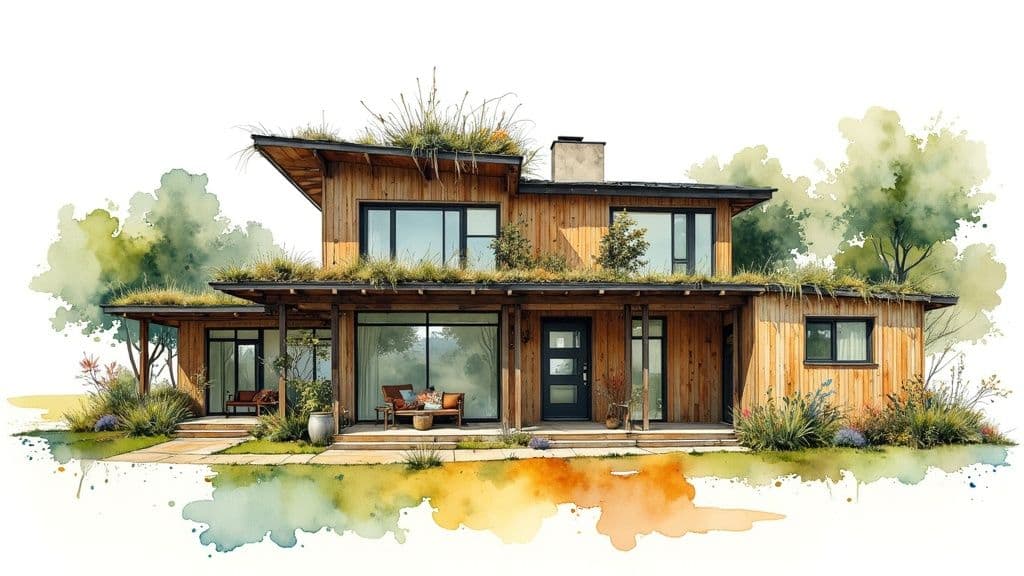
This style of photography appeals directly to tech-savvy buyers by demonstrating how technology simplifies daily life. Major builders like Lennar, with their Amazon Alexa-enabled homes, and developments featuring Google Home or Apple HomeKit integration have popularised this approach. The goal is to present these features not as complicated gadgets, but as seamless, intuitive enhancements to the home environment, promising comfort, efficiency, and peace of mind.
Photographing smart home features requires a focus on interaction and lifestyle. The key is to show the technology in a way that feels natural, useful, and effortlessly integrated into the home's design.
As environmental awareness grows, new home images that highlight sustainability are becoming increasingly powerful. This style of photography moves beyond simple aesthetics to tell a story of conscious design, energy efficiency, and a harmonious relationship with nature. It focuses on features that appeal to eco-conscious buyers, showcasing everything from green roofs and solar panels to reclaimed materials and rainwater harvesting systems.
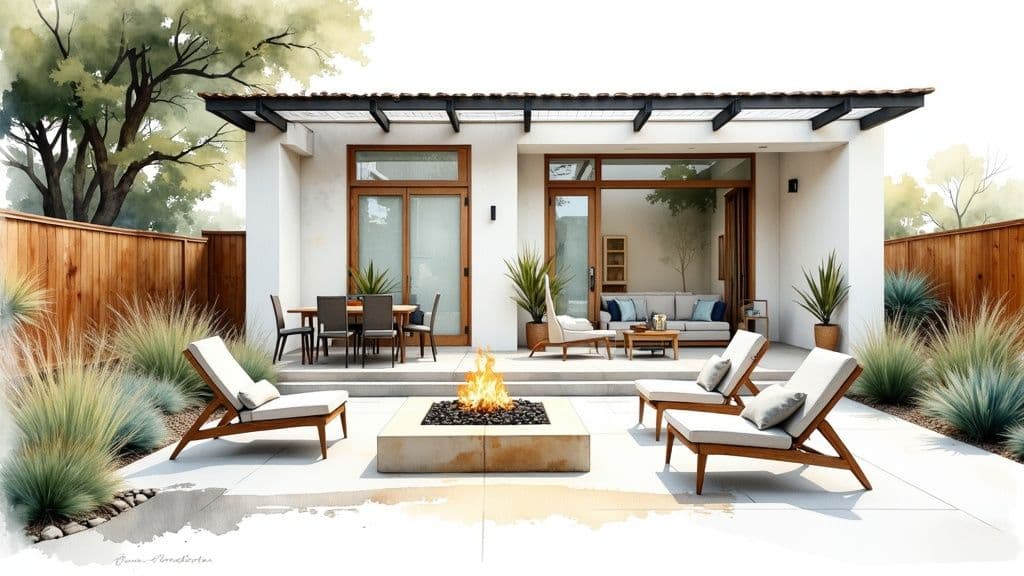
The goal is to visually communicate the long-term benefits of an eco-friendly home, such as reduced energy bills and a smaller carbon footprint. These images often depict homes that achieve certifications like LEED or Passive House, blending innovative technology with natural, organic elements. The resulting visuals are not just beautiful; they are aspirational, representing a smarter, more responsible way of living that resonates deeply with modern audiences.
Photographing a sustainable home means highlighting the features that make it special. Your images should educate the viewer on the home’s green credentials while maintaining a visually appealing composition.
The open concept floor plan has become a hallmark of modern living, and capturing its essence is crucial for compelling new home images. This style of photography focuses on showcasing spacious, flowing layouts where the kitchen, dining, and living areas merge into one cohesive space. The goal is to highlight the sense of freedom, light, and versatility that these barrier-free designs offer.
Popularised by design shows on HGTV and championed by figures like Joanna Gaines, these images appeal directly to contemporary family lifestyles. They emphasise sight lines that connect different functional zones, the abundant flow of natural light, and the adaptability of the space for both daily life and entertaining. The best shots make a home feel expansive, inviting, and brilliantly organised.
Photographing an open concept layout requires a strategic approach to convey its scale and functionality without making it feel empty or chaotic. Your aim is to show how each area works together harmoniously.
A new home is more than just its interior; it's about the lifestyle it enables. Images showcasing a backyard oasis or an extended outdoor living space tap directly into this aspiration, presenting the property not just as a house, but as a personal resort. These new home images feature everything from outdoor kitchens and fire pits to stunning pools and meticulously landscaped gardens, effectively extending the home’s usable square footage.
This style highlights the seamless transition between indoor and outdoor living, a hugely desirable feature in many modern designs. By showcasing a beautiful patio or a poolside lounge, you’re selling a dream of relaxation, entertainment, and connection with nature. It’s a powerful way to demonstrate how a property’s value goes far beyond its four walls, as seen in luxury Florida estates and contemporary Californian homes with infinity pools.
Photographing an outdoor oasis is about capturing an atmosphere of leisure and luxury. The goal is to make the viewer imagine themselves enjoying the space.
Some of the most engaging new home images don't even show a finished property. Documentary-style photos that capture a home’s evolution, from the initial groundbreaking to the final touches, offer a compelling behind-the-scenes narrative. This approach builds excitement and trust, providing potential buyers with transparent proof of quality craftsmanship and superior materials.
This style of photography transforms the construction process into a powerful marketing tool. Builders can showcase their meticulous attention to detail at every stage, from laying the foundation to installing intricate fixtures. For buyers, these images create a deeper connection to their future home, allowing them to follow along and appreciate the work that goes into its creation. It’s a strategy used effectively by major builders and popularised on social media by custom home creators.
Documenting a build requires a storyteller's eye, focusing on progress, people, and precision. The goal is to create a visual log that is both informative and exciting.
Not all new home images are captured through a camera lens. Virtual staging and 3D renders have revolutionised how we visualise potential homes, transforming empty rooms into fully furnished, inviting spaces. This technology uses sophisticated software to digitally add furniture, decor, and finishes, helping buyers see a property's true potential without the cost and effort of physical staging.
From pre-construction marketing that showcases a home before it’s even built to adding life to a vacant listing, these computer-generated images are often indistinguishable from traditional photography. They allow for incredible flexibility, enabling marketers to tailor the decor to specific target demographics or even showcase different design possibilities for the same room.
Creating effective and ethical staged new home images requires a blend of technical skill and design sensibility. The goal is to inspire, not deceive.
| Item | Implementation Complexity 🔄 | Resource Requirements ⚡ | Expected Outcomes 📊 | Ideal Use Cases 💡 | Key Advantages ⭐ |
|---|---|---|---|---|---|
| Modern Minimalist New Home Exterior | Medium 🔄 | High (quality materials needed) ⚡ | Timeless appeal, spacious feel 📊 | High-end residential, urban infill, eco-conscious buyers 💡 | Clean, energy-efficient, increases property value ⭐ |
| Luxury New Home Interior Staging Photos | High 🔄 | Very High (staging + pro photography) ⚡ | Faster sales, higher prices 📊 | High-end sales, competitive markets, vacant & new homes 💡 | Emotional connection, showcases space potential ⭐ |
| Smart Home Technology Integration Photos | Medium-to-High 🔄 | Medium (tech devices & setup) ⚡ | Increased home value, convenience 📊 | New developments, tech-focused markets, millennials 💡 | Demonstrates modern convenience and energy savings ⭐ |
| Sustainable and Eco-Friendly Home Imagery | Medium 🔄 | Medium-to-High (special materials) ⚡ | Market differentiation, long-term savings 📊 | Eco-conscious markets, incentive zones, millennials 💡 | Positive environmental impact, tax benefits ⭐ |
| Open Concept Floor Plan Photography | Medium 🔄 | Medium (wide-angle lenses, staging) ⚡ | Spacious look, natural light, family friendly 📊 | Family homes, entertaining buyers, modern styles 💡 | Enhances flow and light, versatile layouts ⭐ |
| Outdoor Living Space and Backyard Oasis Photos | Medium 🔄 | High (landscaping, staging) ⚡ | Increased usable space, lifestyle appeal 📊 | Warm climates, luxury homes, large lots 💡 | Extends living area, strong market differentiation ⭐ |
| New Construction Progress and Development Photos | Medium 🔄 | Medium (consistent shoots over time) ⚡ | Builds trust, educational, engagement 📊 | Pre-sales marketing, builder credibility, custom clients 💡 | Transparency, documents quality and process ⭐ |
| Virtual Staging and 3D Rendered Home Visualizations | Medium 🔄 | Low to Medium (software & design) ⚡ | Cost-effective staging, flexible design 📊 | Vacant homes, pre-construction, remote buyers, budget 💡 | Low cost, multiple design options, remote-friendly ⭐ |
The journey from a blank canvas to a cherished home is profoundly visual. Throughout this exploration, we've navigated a gallery of possibilities, from the crisp, clean lines of modern minimalist exteriors to the inviting warmth of a fully-realised backyard oasis. Each category of new home images we've examined serves a distinct and powerful purpose in the property narrative. They aren't just pictures; they are stories waiting to be told.
We've seen how luxury staging photos build an aspirational lifestyle, while smart home visuals communicate cutting-edge convenience. Images of sustainable features appeal to the eco-conscious buyer, and open-concept floor plan photography helps potential owners visualise the flow and connection of their future living space. This visual storytelling is what transforms a building into a home in the mind of the consumer.
Harnessing the power of these images requires a strategic approach. It's about moving from passive appreciation to active creation. Your next steps should focus on curating a visual portfolio that resonates directly with your target audience.
Mastering this visual language is no longer optional; it's the cornerstone of modern property marketing. High-quality, purposeful new home images build credibility, foster emotional connections, and ultimately, drive sales. By investing in a diverse and thoughtfully curated collection of visuals, you equip your brand with the tools needed to captivate and convert, turning browsers into believers and prospects into proud homeowners. Your vision deserves to be seen, and with the right images, it will shine.
Ready to create stunning, unique new home images in seconds? With Instastock, you can generate custom, photorealistic visuals that perfectly match your brand's style and marketing needs, from staged interiors to architectural concepts. Stop searching for the perfect image and start creating it with Instastock.

Discover 8 top construction companies logos that build strong brands. Get strategic design insights and actionable tips to inspire your next logo project.

Discover 8 innovative identity cards designs that can elevate your brand. Get inspired and create memorable identity cards designs for 2025!

Discover tips to design an effective business letterhead template that boosts your brand and credibility. Start crafting yours today!